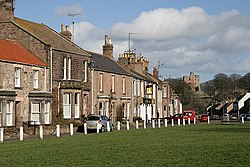Norham: Difference between revisions
Redirected page to Norhamshire |
|||
| (One intermediate revision by one other user not shown) | |||
| Line 1: | Line 1: | ||
{{Infobox town | |||
|name=Norham | |||
|county=Northumberland | |||
|picture=Houses at Cross View, Norham - geograph.org.uk - 1202939.jpg | |||
|picture caption=Norham | |||
|os grid ref=NT900473 | |||
|latitude=55.719737 | |||
|longitude=-2.160113 | |||
|population= | |||
|census year= | |||
|post town= | |||
|postcode=TD15 | |||
|dialling code= | |||
|LG district=Northumberland | |||
|constituency=Berwick-upon-Tweed | |||
}} | |||
'''Norham''' is a village in the very north of [[Northumberland]], on the south bank of the [[River Tweed]], opposite [[Ladykirk]] in [[Berwickshire]]. The Tweed is bridged here, carrying the B6470. | |||
The village grew up in the Middle Ages west of [[Norham Castle]], a stronghold owned by the Bishops of Durham, and this parish formed [[Norhamshire]], one of the liberties of the Bishops which collectively are known as [[North Durham]]. | |||
==History== | |||
Norham has a strategic position on what was long the border of two warring kingdoms, and it suffered repeated attack from [[Scotland]] and from reivers of both kingdoms who kept the borderland a lawless place until the days of King James VI and I. It became the headquarters of the English Warden of the Middle March. | |||
On 29 August 1513 after six days of heavy bombardment and assault, Norham surrendered to King James IV of Scotland, from which stronghold James marched south to defeat and death at Flodden Field. | |||
On the evening of 25 March 1603, Sir Robert Carey, the Lord Warden, rode into in Norham, on just the second day of his ride from [[London]] with news of the death of Queen Elizabeth I. He sent orders out from Norham for King James of Scotland to be proclaimed King of England in all the towns of the borders, to give the reivers no excuse for believing the Queen's peace suspended for want of a monarch. The next evening he arrived in [[Edinburgh]].<ref>Leanda de Lisle: ''After Elizabeth'' (2005)</ref> | |||
==Outside links== | |||
{{commons}} | |||
==References== | |||
{{reflist}} | |||
Latest revision as of 08:52, 12 February 2016
| Norham | |
| Northumberland | |
|---|---|
 Norham | |
| Location | |
| Grid reference: | NT900473 |
| Location: | 55°43’11"N, 2°9’36"W |
| Data | |
| Postcode: | TD15 |
| Local Government | |
| Council: | Northumberland |
| Parliamentary constituency: |
Berwick-upon-Tweed |
Norham is a village in the very north of Northumberland, on the south bank of the River Tweed, opposite Ladykirk in Berwickshire. The Tweed is bridged here, carrying the B6470.
The village grew up in the Middle Ages west of Norham Castle, a stronghold owned by the Bishops of Durham, and this parish formed Norhamshire, one of the liberties of the Bishops which collectively are known as North Durham.
History
Norham has a strategic position on what was long the border of two warring kingdoms, and it suffered repeated attack from Scotland and from reivers of both kingdoms who kept the borderland a lawless place until the days of King James VI and I. It became the headquarters of the English Warden of the Middle March.
On 29 August 1513 after six days of heavy bombardment and assault, Norham surrendered to King James IV of Scotland, from which stronghold James marched south to defeat and death at Flodden Field.
On the evening of 25 March 1603, Sir Robert Carey, the Lord Warden, rode into in Norham, on just the second day of his ride from London with news of the death of Queen Elizabeth I. He sent orders out from Norham for King James of Scotland to be proclaimed King of England in all the towns of the borders, to give the reivers no excuse for believing the Queen's peace suspended for want of a monarch. The next evening he arrived in Edinburgh.[1]
Outside links
| ("Wikimedia Commons" has material about Norham) |
References
- ↑ Leanda de Lisle: After Elizabeth (2005)
